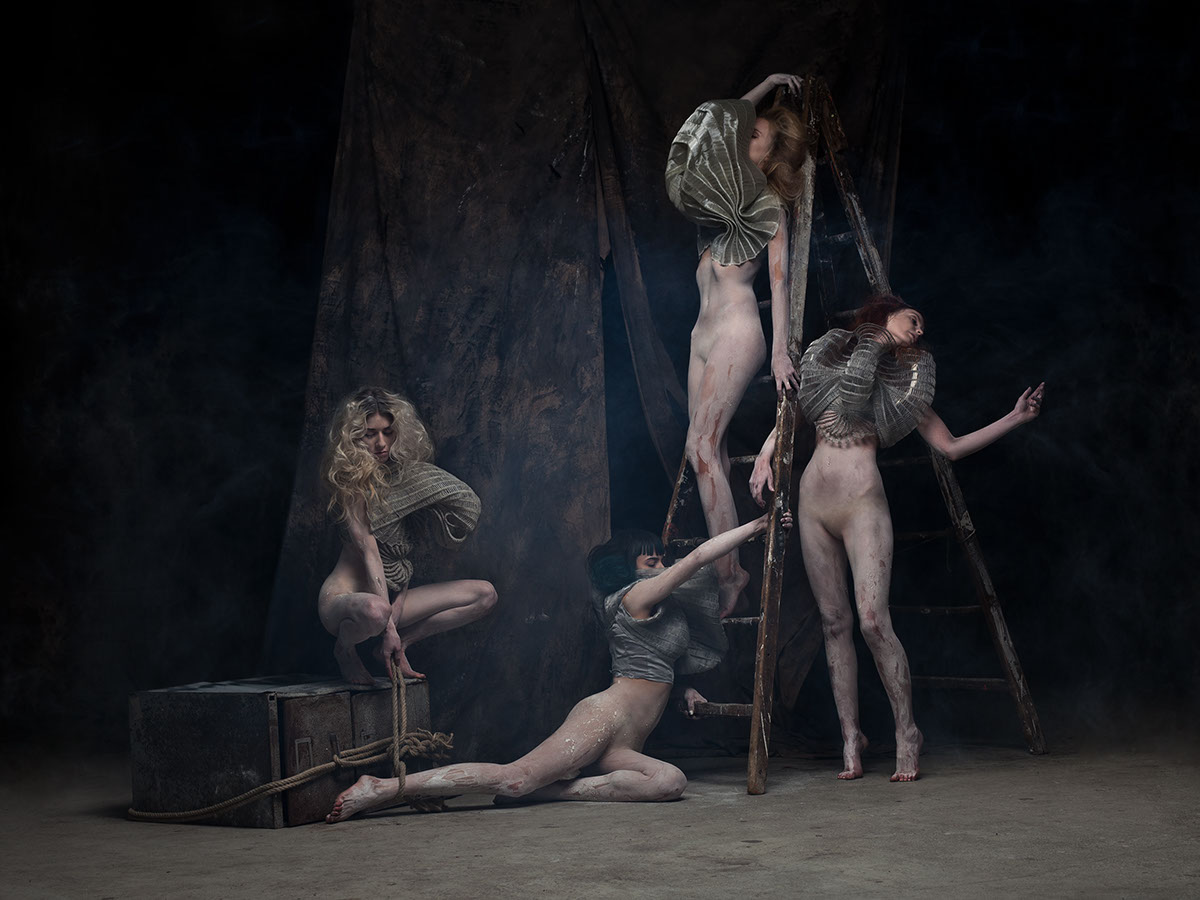









A child is standing in front of a vivarium, watching with cruel authority a confined and asphyxiated microcosm the wings of which were cut. White butterflies try to fly in vain, resigned, blurred by the opaque light of a lid. They struggle and fight, hit the dusty ground and eventually admit their claustrophobia. The long agony is looming.
The pictorial quality of this work is striking. The picture is baroque. The chiaroscuro defines the outlines of pale bodies on a dark abyss. It lives in a clogged space with minimum visibility and no depth. No chance is left to flight.
A dark character comes out between light and shadow. A contrasted division gives way to the multiple ambivalences laying the basis of the series and shaping up its atmosphere. In fact it gives a feeling of heaviness, in which the lightness of the characters will seem to struggle and wither even more. The choking sensation becomes pervasive, from the physical frame to the flattening light on figures.
Caravaggio's sharpness in one of Goya's nightmares. These pictures are on the verge of fantastic and mystic temptation. The coming of an anonymous and gloomy cult is carried by a classical religious pattern.
This back and forth echoes in the indiscernible roles of the asexual beings shaped like women, executioners as much as martyrs in the fight or ritual dance in which they seem to be engaged. The lack of identity gives them masks with uncanny neutrality and total absence. One would like to see the strings moving these articulated puppets and making them look human. White-skinned bodies in girdles, whose natural curbs are disrupted by strange bustiers suggesting the chrysalis, the slough, the rib cage that all shut the being in the body.
Instinctive and primary, the behaviour is closer to compulsive animal intensity, just between aggressiveness and docility. Like mutants ready to devour each other. Damaged and transmuted bodies coexist with feminine grace, always ambivalent and unstable.
Through fine aesthetics, cunning and complexity of action appear. Behind physical fight, mind fight. It is the portrait of the sweet face of chaos.
Fantasized and projected into modern divinities, these beings seem to face an impossible rise, an eternity, Sisyphus' punishment. A certain vanity exudes from the similarity with painting; the creatures seem to be aware of the pointlessness of their weakening struggle.
Reaching abandon, their obvious idleness only gives way to loss, agony and, eventually, surrenders to oppressive force, ubiquitous and intangible. This is where mechanics perform; subjects are a pretext to reveal what is not visible. Apparition through omission.
This is how the power of images performs, through allegory. Dehumanized beings are used to reflect an idea, a dream, a shapeless mystery that one would like to see and understand. Image immortalises strength into action, it materialises feeling. It's a psychic metaphor. Something seems to be happening. A tension or breaking, just grasped in photographic instantaneousness. The symbolic depth raises questions and tension makes us think.
A dark character comes out between light and shadow. A contrasted division gives way to the multiple ambivalences laying the basis of the series and shaping up its atmosphere. In fact it gives a feeling of heaviness, in which the lightness of the characters will seem to struggle and wither even more. The choking sensation becomes pervasive, from the physical frame to the flattening light on figures.
Caravaggio's sharpness in one of Goya's nightmares. These pictures are on the verge of fantastic and mystic temptation. The coming of an anonymous and gloomy cult is carried by a classical religious pattern.
This back and forth echoes in the indiscernible roles of the asexual beings shaped like women, executioners as much as martyrs in the fight or ritual dance in which they seem to be engaged. The lack of identity gives them masks with uncanny neutrality and total absence. One would like to see the strings moving these articulated puppets and making them look human. White-skinned bodies in girdles, whose natural curbs are disrupted by strange bustiers suggesting the chrysalis, the slough, the rib cage that all shut the being in the body.
Instinctive and primary, the behaviour is closer to compulsive animal intensity, just between aggressiveness and docility. Like mutants ready to devour each other. Damaged and transmuted bodies coexist with feminine grace, always ambivalent and unstable.
Through fine aesthetics, cunning and complexity of action appear. Behind physical fight, mind fight. It is the portrait of the sweet face of chaos.
Fantasized and projected into modern divinities, these beings seem to face an impossible rise, an eternity, Sisyphus' punishment. A certain vanity exudes from the similarity with painting; the creatures seem to be aware of the pointlessness of their weakening struggle.
Reaching abandon, their obvious idleness only gives way to loss, agony and, eventually, surrenders to oppressive force, ubiquitous and intangible. This is where mechanics perform; subjects are a pretext to reveal what is not visible. Apparition through omission.
This is how the power of images performs, through allegory. Dehumanized beings are used to reflect an idea, a dream, a shapeless mystery that one would like to see and understand. Image immortalises strength into action, it materialises feeling. It's a psychic metaphor. Something seems to be happening. A tension or breaking, just grasped in photographic instantaneousness. The symbolic depth raises questions and tension makes us think.

